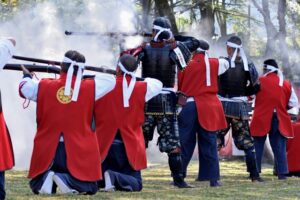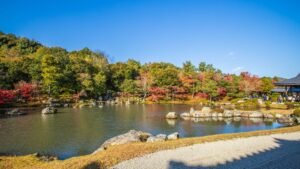Okehazama Battlefield: Genius, Nobunaga's Victory
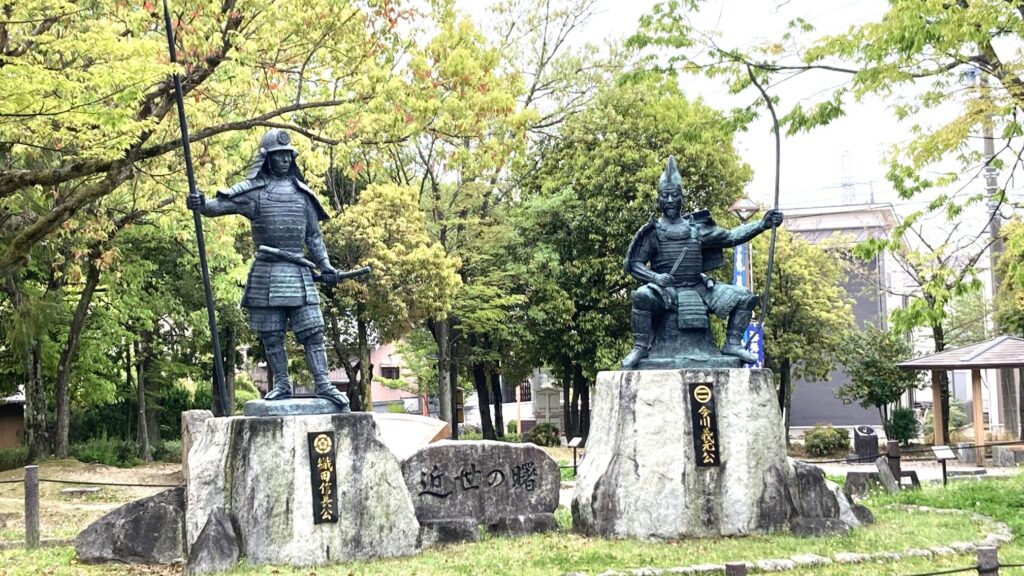
"Charge!, Charge!" Oda Nobunaga (1534-1582, 織田信長) ordered the fierce charge to his elite troops on the headquarters of Imagawa Yoshimoto. On May 19, 1560, a pivotal event occurred in Japanese history as Imagawa Yoshimoto (1519-1560, 今川義元), renowned as the greatest archer of the Tokaido region and a prominent feudal lord, was defeated by 2,000 elite troops commanded by Oda Nobunaga, the lord of Kiyosu Castle. This decisive battle took place at Okehazama while Yoshimoto was on his way to conquer Owari with a formidable force of 25,000 soldiers. Yoshimoto's downfall marked a significant turning point in Japan's Warring States period, reshaping the geographical landscape and setting a new period for the subsequent unification of Japan.
Two Days of the Battle of Okehazama
On a very hot day, May 19, 1560, lunar calendar (June 12, 1560 AD), a pivotal event occurred in Japanese history as Imagawa Yoshimoto, renowned as a prominent feudal lord, was defeated by 2,000 elite troops commanded by Oda Nobunaga, the lord of Kiyosu Castle. This decisive battle occurred at Okehazama while Yoshimoto was on his way to conquer Owari with a formidable force of 25,000 soldiers. Yoshimoto's downfall marked a significant turning point in Japan's Warring States period, reshaping the territories of many warlords and setting a new period for the subsequent unification of Japan.
On May 18, the day before the battle, Tokugawa Ieyasu (1543-1616, 徳川家康), Yoshimoto’s warrior, succeeded in bringing army provisions into Odaka Castle. Early in the morning of the following 19th, Ieyasu and another Yoshimoto force started an attack on Oda's Marune and Washizu fortresses surrounding Odaka Castle, causing them to fall around 10:00 a.m. Receiving news of the Imagawa's attack on both fortresses, Nobunaga danced Atsumori while singing “The 50 years of the human realm, one of 6 realms of Buddhism, it’s too short to live”, and set out from Kiyosu Castle with only six cavalrymen. Arriving praying for victory at Atsuta Shrine around 8:00 a.m., Nobunaga hurried to the Zenshoji Fortress.
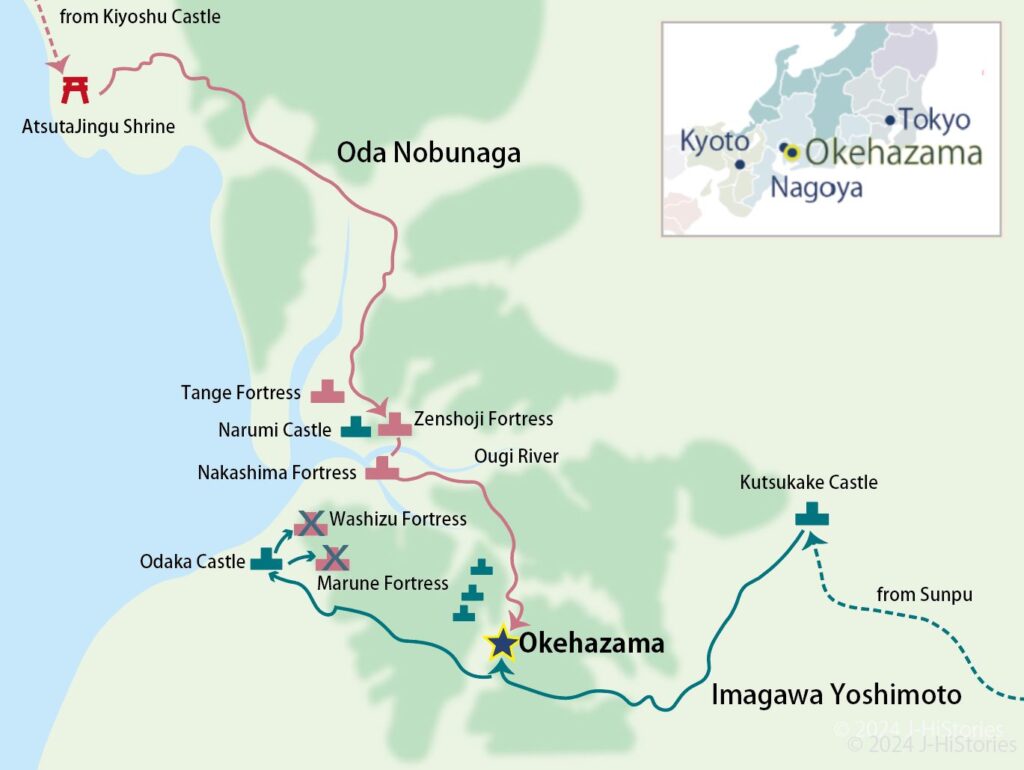
About 3,000 troops were waiting for Nobunaga at Zenshoji Fortress, following Nobunaga's order last night. Around 10:00 a.m., Nobunaga had a streamer set up at Zenshoji Fortress and also ordered a 300-man ranger force to attack Imagawa's vanguard force. He led about 2000 elite troops across the Ougi River and entered Nakajima Fortress. He proceeded along the mountain bank along the Ougi River toward Okehazama. for a while to avoid detection by Imagawa's forces in Takaneyama, Makuyama, and Makiyama mountains and marched to a wooded area near Imagawa's main camp. As they approached Okehazama, Yoshimoto's main camp, a heavy thunderstorm mixed with hail was brewing.
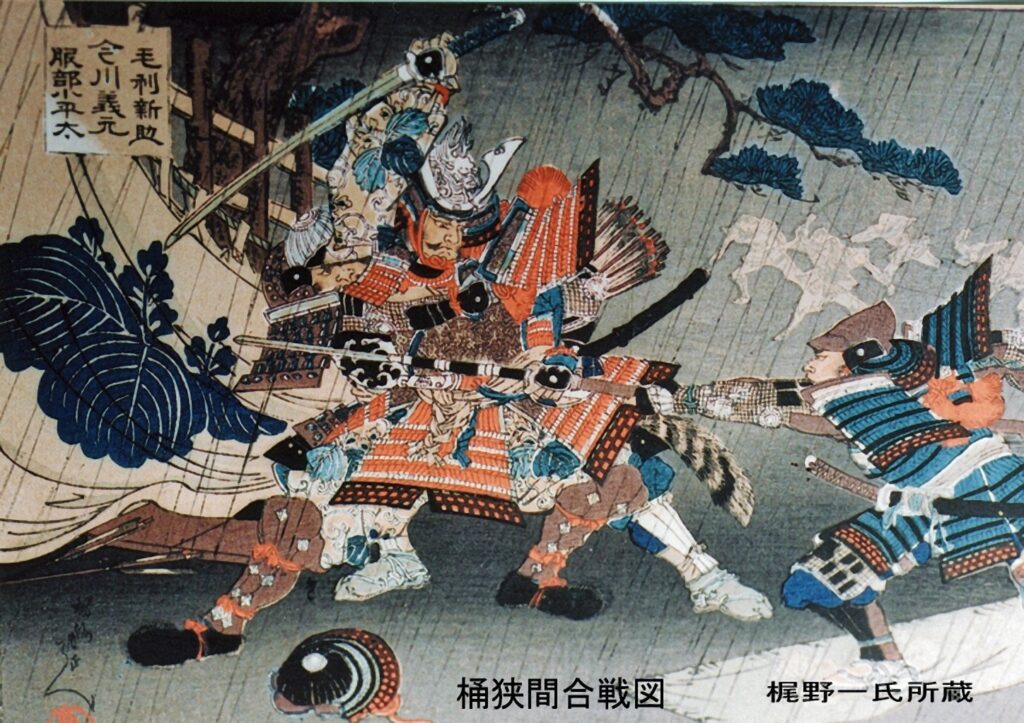
@ Okehazama Battlefield Preservation Society
(NPO法人 桶狭間古戦場保存会提供)
Around 11:00 a.m., Yoshimoto sang a song in high spirits upon receiving the news of the fall of the two fortresses. Then, while the Imagawa forces were taking a short rest in their camp on a small hill in Okehazama, thunder, and heavy rainstorms struck mercilessly. The Imagawa soldiers took off their helmets and armor and took shelter in a wooded area to protect themselves from the lightning strikes. At that moment, when the danger of a lightning strike had passed, Nobunaga ordered, "Now is the time! Attack! Kakare~!" The sudden appearance of Nobunaga's forces caused havoc in Imagawa's main camp. Pushed by Nobunaga's elite troops one after another, Imagawa Yoshimoto himself was gradually pushed and was finally killed at Dengakutsubo (present-day Okehazama Battlefield Park). The battle was over in just a few hours.
Yoshimoto Attacked Nobunaga During his Struggle to unify Owari
In March 1552, eight years before the battle, at his father's funeral, Nobunaga, without a hakama and with his Chasen-mage hairstyle (looks like a tea whisk), walked up to the altar and threw incense powder on his father's tablets. This act, reflective of Nobunaga's unconventional demeanor, caused the loss of centripetal force within the Oda family, leading to a split. Some revolted against Nobunaga, who held one-third of Owari Province.
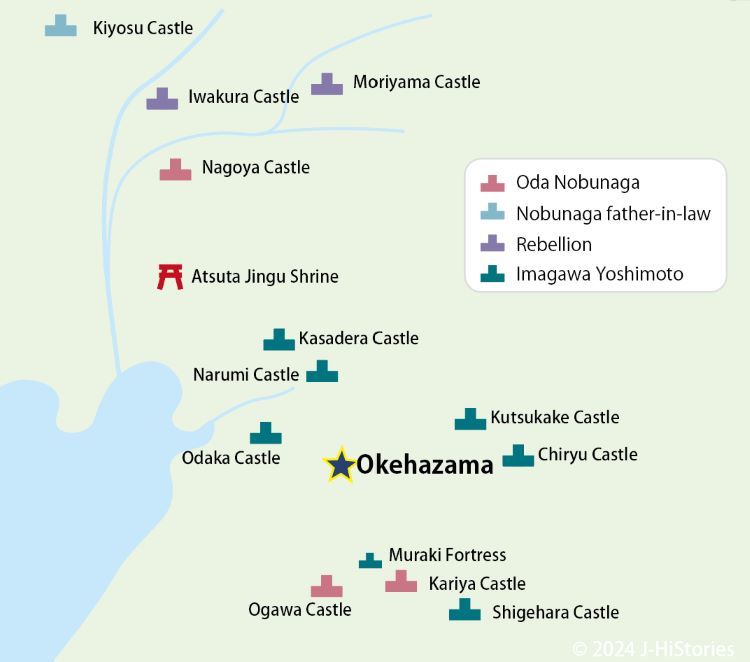
Attacked by the lord of Kiyosu Castle (August 1552), the betrayal of the lord of Kasadera, Narumi, Odaka, and Kutsukake Castles to the Imagawa clan (1553), the rebellion of his half-brother, the lord of Moriyama Castle (1555), the rebellion of his brother (May 1556), and the news of down throwing Nobunaga by the lord of Iwakura Castle (Oda's main family) (July 1558). While facing many challenges, Nobuanga was put in a harsh situation by Yoshimoto, who occupied Shigehara Castle on the Oda side and built Muraki Fortress (1554) to divide Ogawa Castle and Kariya Castle on the Oda side. Nobunaga fought a series of some 40 battles under harsh conditions. Despite these challenges, Nobunaga managed to quell rebellions, employing firearms for the first time at the Battle of Muraki Fortress, which fell under his control. Then, he built fortifications surrounding Narumi Castle and Odaka Castle, which had been previously turned over to the Imagawa, in preparation for the coming battle.
Given the longstanding warfare against Imagawa clans, dating back to his father’s era, a clash seemed almost inevitable. Meanwhile, Yoshimoto had seized Suruga, Omi, and Mikawa regions, and was steadily preparing to invade the Oda domain to capture Atsuta Port, its main economic hub of Owari Province. In May 1560, Yoshimoto launched his assault on Owari with 25,000 forces from Sunpu Castle. However, Nobunaga emerged victorious, defeating Yoshimoto.
Tenka Fubu Begins

The authority of the Muromachi shogunate had waned since the Onin War, and amid the Warring States Period, Nobunaga's territorial expansion gained momentum after his victory at the Battle of Okehazama. Seven years later, in 1567, Nobunaga made a significant declaration upon entering Gifu Castle, articulating his vision of Tenka Fubu, as the first feudal lord to advocate for the pacification and unification of Japan centered around Kyoto by supporting Ashikaga shoguns. To symbolize this vision, Nobunaga began using the red seal of Tenka Fubu on his letters.
Formula for Victory
What was the reason for the victory of Oda Nobunaga with 3,000 troops over Imagawa Yoshimoto who led 25,000 soldiers and had ties to the Ashikaga shoguns of the Muromachi Shogunate? Although there are several theories, one formula for victory is presented here.
The Strategy of Dispersing Yoshimoto’s 25,000 Troops
The strategy of dispersing Yoshimoto’s 25,000 troops and significantly reducing the number of soldiers defending his main camp to target solely Yoshimoto proved successful. Among 5,000 to 6,000 soldiers supposedly guarding the main camp, some were involved in non-combat roles such as carrying Yoshimoto's palanquin and preparing meals, with the actual number of battle-ready troops estimated to be less than 2,000 (by Professor Emeritus, Shizuoka University, Owada Tetsuo). Conversely, Nobunaga's attacking force consisted of approximately 2,000 elite soldiers, nearly the same in number. It could be said that Yoshimoto was supposed to be defeated. So, how did Nobunaga manage to reduce the effective number of soldiers defending Yoshimoto’s main camp?
Tactics 1: On the morning of the 19th, Nobunaga effectively pinned down Ieyasu's and Asahina's armies at the Marune and Washizu Fortresses, ensuring they could not help Yoshimoto headquarters. Notably, Nobunaga did not reinforce these fortresses, where intense battles raged on, instead, choosing to concentrate his forces on assaulting Imagawa's main camp. This strategic decision allowed him to maximize his forces in the crucial attack on Yoshimoto.
Tactics 2: Nobunaga deployed numerous streamers at Zenshoji Fortress to create the illusion of his presence, pulling the Imagawa forces off guard.
Tactics 3: Nobunaga ordered approximately 300 troops to attack Imagawa's vanguard force, drawing several hundred men (exact number unknown) away from Imagawa's main camp and further weakening the defenses of Yoshimoto.
The decision to raid the main camp and the thorough secrecy of the operation
The situation surrounding Nobunaga remained unstable as to who might betray him at any moment, even though he was on the verge of unifying Owari Province. For this reason, he was wary of leaks of his strategy, and on the 18th, the eve of the battle, he did not hold a military meeting with his vassals gathered at Kiyosu Castle, but rather engaged in idle chitchat. As night fell, the warlords returned home muttering, “Now the Oda family will be destroyed." Nobunaga, on the other hand, must have thoughts only about the Oda family's existential battle. This was because Nobunaga had received two important pieces of information that could determine victory or defeat. These were (1) the Imagawa forces were to attack the Marune and Washizu Fortresses early in the morning of the following day, the 19th, and (2) Yoshimoto's main camp was being set up on a small hill in Okehazama. For Nobunaga, the Okehazama was an area where he had run around with his Kosho (pages) since his youth, and he would have known the roads, mountains, and rivers very well. He must have thought he had a chance of victory as long as Yoshimoto entered the Okehazama. The siege warfare recommended by his vassals was a tactic based on the premise that reinforcements would come from his allies, the “rearguard,” and for Nobunaga at that time, the rearguard was not to be expected. The only person he could rely on was his father-in-law, Saito Dosan, who had already passed away. Nobunaga's “Kowaka Mai” may have been a dance to mark his determination to fight against the Imagawa forces, one of the greatest feudal lords in the Warring States period. And the die was cast.
Intelligence Capability
The crucial information brought to Nobunaga was that Yoshimoto's main army was only about 5,000 men or one-fifth of his total army of 25,000, and moving from Kutsugake Castle to Odaka Castle. Two days before the decisive battle, Sena Ujitoshi, Imagawa's commander, set up the main camp near Okehazama Hill with 200 soldiers. Based on this information, Nobunaga was convinced that the only place for Yoshimoto's main camp would be here, at Okehazama, since there was a pond to provide water for Yoshimoto's 100 horses.
In addition, Nobunaga received the information that Yoshimoto had left Kutsukake Castle not on horseback but in a palanquin. This information allowed Nobunaga to issue a more specific order, “Aim at the palanquin,” in response to the order “All-out attack on Yoshimoto's main camp. In the Warring States period, none of Nobunaga's soldiers knew what Yoshimoto looked like. However, with the “palanquin” as a clear target of the attack, they were able to launch a concentrated all-out attack. The fact that Yanada Masatsuna, who delivered this information to Nobunaga, was awarded the title of the best contributor is a result of how important Nobunaga considered information to be in determining the success or failure of the battle.
Daily Life was Filled with Battles and Plots
To unify Owari, Nobunaga's daily life was filled with battles and plots, but he was full of strategies, tactics, and experience gained through actual battles, and determination as the head of Owari. On the other hand, the Battle of Okehazama was the first battle for Yoshimoto to lead after the death of his assistant, Taigen Sessai, an exceptional military advisor to Yoshimoto, in 1560. The difference in experience and knowledge of actual battles may have greatly affected the battle's outcome. There is no if in history, but one cannot help but think, “If only Sessai had lived.
Blessings of Atsuta Deity
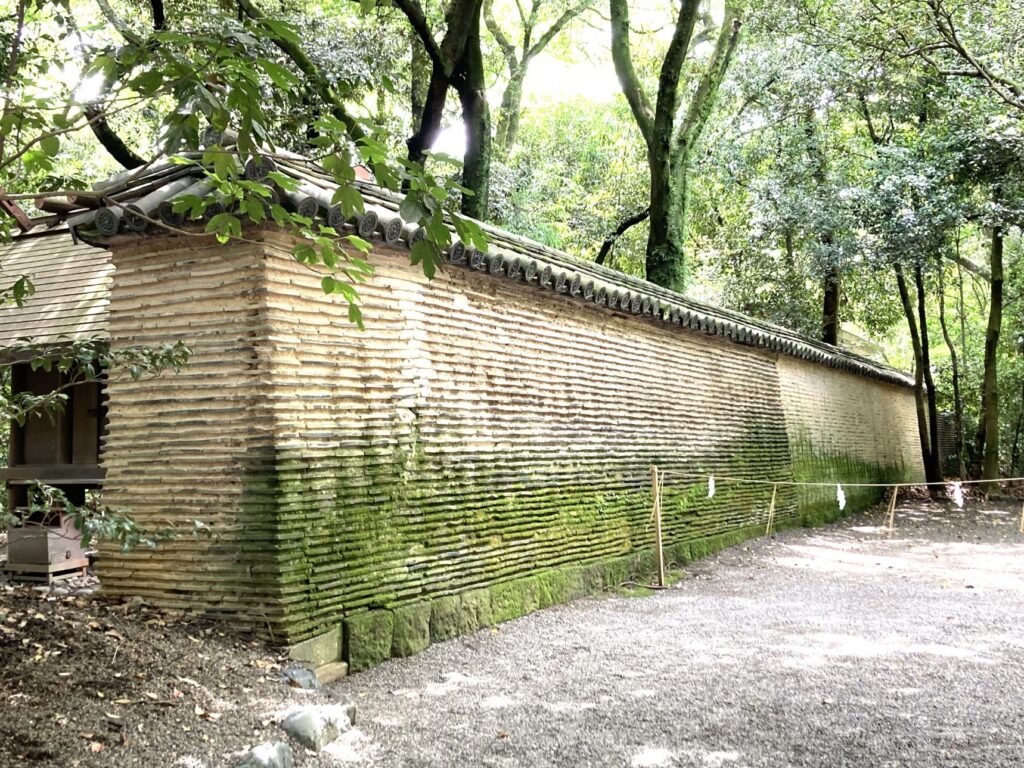
The sudden thunderstorm and heavy rain that struck the Imagawa main force appeared as if a divine boon from the Atsuta Deity had favored Nobunaga. Following his victory, Nobunaga expressed his gratitude by dedicating a 400-meter-long earth wall to the Atsuta Jingu Shrine, recognizing the divine intervention that contributed to his victory. (The Biography of Nobunaga)
At Kiyosu Castle, Nobunaga identified Yoshimoto’s head and conducted a service for him by reciting the Senbukyo Buddhist Sutra. After that, Yoshimoto’s head was sent back to Yoshimoto’s Sunpu Castle.
Yoshimoto's Sword to Nobunaga and the Successive Shoguns
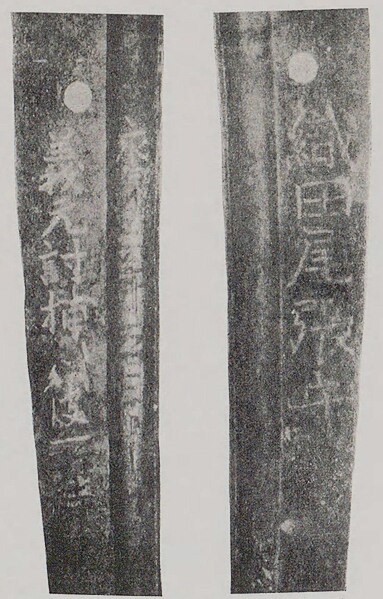
@NDL
Yoshimoto's favorite sword, Yoshimoto-samonji, which he wielded during his battle against Nobunaga’s troops at Okehazama, became Nobunaga's prized possession. Nobunaga made it his favorite sword by inlaying the words “Yoshimoto was defeated on May 19, 1590” on the front of the sword and “Oda Nobunaga, Provincial Governor of Owari” on the back. In 1878, the sword was dedicated to the Kenkun Shrine in Kyoto, which enshrines Nobunaga's spirit, and it has remained to the present day. This treasured sword, which passed through the hands of Lord Yoshimoto, Nobunaga, Hideyoshi, Ieyasu, and successive Tokugawa Shoguns, is a significant cultural artifact that continues to tell the story of Yoshimoto and Nobunaga. Visit Okehazama Battlefield Park to walk through the historic site where these two great warlords clashed, and feel firsthand the turning point in history. It was a major shift from the nationwide rivalry era to the country's unification.
Interviewed Kajino Yukio (Auditor and Director of the Guide at The NPO, Okehazama Battlefield Preservation Society)
The Battle of Okehazama Timeline
| Oda Nobnaga | Imagawa Yoshimoto | ||
| 1560/5/12 | Left Sunpu for Owari | ||
| 1560/5/18 | Evening | A meeting at Kiyosu Castle but no military discussions | Arrived at Kutsukake Castle |
| Night | Received two pieces of information - Yoshimoto's main camp at Okehazama - Yoshimoto will attack Marune & Washizu Fortress on May 19 morning | Brought army provisions into Odaka Castle | |
| 1560/5/19 | Early morning | Received the beginning of Yoshimoto's attack on Marune & Washizu Fortress | Yoshimoto's forces started to attack on Marune & Washizu Fortress |
| Danced “Atsumori” at Kiyosu Castle | |||
| Get out from Kiyosu Castle with only six cavalrymen | |||
| 8am | Prayed for victory at Atsuta Shrine | ||
| 10am | Arrived at Zenshoji Fortress and had a streamer set up | Heard the fall of Marune & Washizu Fortress | |
| Ordered a 300-man ranger force to attack Yoshimoto's vanguard force. | |||
| 11am | Crrosed the Ougi River and entered Nakajima Fortress | Sang a song in high spirits upon the fall of the two fortresses | |
| Proceeded along the mountain bank along the Ougi River toward Okehazama | Took a short rest at Okehazama | ||
| A heavy thunderstorm mixed with hail was brewing | |||
| Noon | Ordered to the fierce charge on Yoshimoto's headquarters | Was finally killed at Dengakutsubo | |
Recommendations to Visit
- Access: 30 minutes from Meitetsu Nagoya on the Meitetsu Main Line to Ariamtsu Station. A 22-minute walk. Or take Nagoya City Bus #11 at #2 bus stop. 6 minutes to Okehazama Kosenjo Koen (桶狭間古戦場公園).

